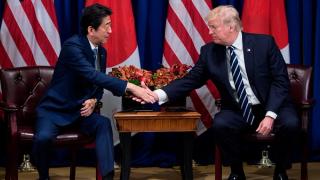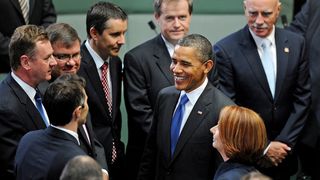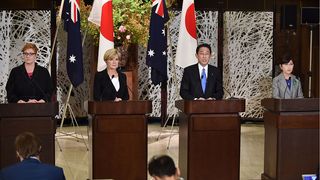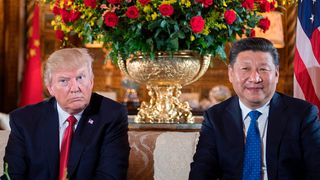Ambassador David B. Shear served as Assistant Secretary of Defense for Asian and Pacific Security Affairs from September 2014 to June 2016, and performed the duties of Principal Deputy Under Secretary of Defense for Policy from June 2016 to January 2017. During this period he oversaw the strategic aspects of President Barack Obama’s “rebalance to Asia” alongside Secretary of Defense Ashton B. Carter. Ambassador Shear delivered a series of lectures in Sydney and Canberra in 2017 as a guest of the United States Studies Centre. The views expressed in this report are his personal opinion and do not reflect the views of the United States Government.
Introduction
A dual crisis haunts America’s Asia policy at a time when China is challenging the United States-led regional order. Early visits to the region by senior Trump administration officials, along with intense attention to the North Korean nuclear problem, point to an illusory continuity in Asia policy. Political squabbling at home and ongoing wars in Iraq and Afghanistan rob Washington of the senior attention and resources needed to blunt China’s rise. This is the crisis of strategic distraction. At the same time, an erratic administration has undermined allied confidence in the credibility of our commitments in the Western Pacific, as our friends begin to question America’s long-term reliability as a trustworthy ally. This is the crisis of American credibility.
The United States and its allies need all the diplomatic leverage they can muster as a surging China attempts to reshape the Asian region to suit its great power interests. But America’s dual foreign policy crises threaten to squander this leverage. The crisis of strategic distraction invites Beijing to fill the gaps between US commitments in Asia and the insufficient resources we devote to fulfilling those commitments.1 The crisis of credibility invites our potentially dispirited allies and partners to either sit on the fence or gravitate towards Beijing, opening further gaps for China to fill. Unsurprisingly, China's President Xi Jinping is already seeking to fill these gaps by portraying China as the new standard-bearer for global free trade and Asian regional order.2
Given the current distaste in both Washington and Beijing for an across-the-board confrontation or general war, these crises set the stage for the peaceful erosion of American power in Asia. Peaceful erosion begins with the slippage of American authority, the decline of US economic salience, the constriction of US military operations in the Western Pacific, and the gradual diminution of our alliances. It ends with Beijing’s establishment of a Sino-centric economic and security order in Asia in which America plays a minimal role. Our only consolation will be that we let it happen peacefully.
An erratic administration has undermined allied confidence in the credibility of our commitments in the Western Pacific, as our friends begin to question America’s long-term reliability as a trustworthy ally. This is the crisis of American credibility.
It doesn’t have to be like this. In a much remarked upon moment during this year’s Shangri-La Dialogue, US Secretary of Defense James Mattis responded to a barrage of questions casting doubt on America’s commitment to the rules-based order, the spread of universal values, and its interest in freedom-of-navigation in the South China Sea. Mattis tried to reassure his interlocutors on all three counts, but he ended by having to borrow from Winston Churchill. “Bear with us,” Mattis said, “once we’ve exhausted all possible alternatives, the Americans will do the right thing.”3
The right thing for America to do is to implement a strategy of peacetime competition in which we compete for influence with China on the basis of a coherent, whole-of-government strategy designed to maximise our diplomatic and strategic leverage. Our allies and partners can bear with us not by bandwagoning with China, but by helping us close the gaps in American influence. Rather than waiting for Washington to return to normal, allies should be taking the initiative to build their own capabilities and strengthening cooperative ties among themselves.
The gravity of China’s challenge
China has the resources
Beijing has the resources it will take to reorder Asia. After overtaking the United States as the world’s largest producer of manufactured goods in 2009, China’s gross domestic product (GDP) surpassed America’s on a purchasing power basis in 2014.4 China has supplanted America as Asian countries’ largest trading partner, and sits on more than three trillion dollars in foreign exchange reserves.5 Growing interdependence between China and the economies of its periphery is inevitable. Everybody wants to cash in on the Chinese dream. It’s clear in Australia. It’s clear in Japan. And it’s particularly clear in Southeast Asia, which is straining for finance to support its great infrastructure build-out. Economically speaking, China is there to help its neighbours. And it is able to do so in substantial numbers. According to some estimates, China can sustain annual direct investment outflows of US$300 billion for the foreseeable future.6

China’s cash, as well as its industrial overcapacity paired with growing demand for financing throughout the region, form the inspiration for Xi’s Belt and Road Initiative. The Chinese see the overland Silk Road Economic Belt as a transportation network linking industrial corridors from China, through Central Asia to Europe; while the Maritime Silk Road will see investment in ports and trade routes throughout the South China Sea and the Indian Ocean rim. It will be financed by a host of new China-led financial entities: the hefty China Development Bank, the Export-Import Bank of China, the Asian Infrastructure Investment Bank, and the Silk Road Fund.7
With trade and investment comes rising geopolitical influence. In fact, Chinese money may already pose as much of an obstacle to US influence in Asia as Chinese weaponry. Beijing is more than ready to help needy local elites, like Malaysian Prime Minister Najib Razak, for whose benefit the Chinese recently bought a large chunk of assets owned by the scandal-ridden 1MDB Bank, with which the embattled leader is associated.8 Beijing’s pockets have also opened for the mercurial Philippine President Rodrigo Duterte. Such largesse comes with a geopolitical price — recall Duterte’s impassioned anti-American rant during his October 2016 visit to Beijing.9
China is devoting a growing level of resources to strengthening its military capabilities. The US Defense Department’s 2017 Annual Report to Congress on Military and Security Developments Involving the People’s Republic of China reports that the Chinese defence budget grew by an average rate of 8.5 per cent per year between 2007 and 2016. China announced a seven per cent increase in 2016 for a total budget of US$144.3 billion, making China the second largest defence spender in the world after the United States. By way of comparison, in the same year Japan spent US$47.2 billion, India spent US$37 billion, and Taiwan spent US$10.5 billion.10
China could soon achieve regional military superiority if the United States and its allies fail to attend to the East Asian military balance.
The People’s Liberation Army (PLA) is engaged in an ambitious military modernisation program, much of which is geared toward preventing US forces from operating effectively within the “first island chain” — the string of land features stretching from the Kuril Islands and Japanese archipelago, to Taiwan, the Philippines, Borneo, and Malaysia. China’s new capabilities are known as “anti-access/area denial” platforms for a reason. They include advanced submarines, missile systems, sea mines, and fighters; and are being built across-the-board in the air, maritime, space, electromagnetic, and cyber domains. All of this has increased the risk to US and allied forces operating near Chinese weapons with increased range and lethality.11
While America continues to maintain its edge in most areas, years of spending on weapons needed to fight in the Persian Gulf and Afghanistan — which are different from those needed in East Asia — has posed increasing difficulties for Pentagon planners. The United States continues to enjoy a global strategic advantage. But China could soon achieve regional military superiority if the United States and its allies fail to attend to the East Asian military balance.12
China also has the will
The Chinese Communist Party has the will to reshape the region. Growing wealth and military power have led Chinese policymakers to reassess their regional goals. Indeed, President Xi’s grandiose appeal to the “Chinese dream of the rejuvenation of the great Chinese nation” has replaced his predecessors’ more modest formulations.13 Xi recognises China’s new wealth and influence offer significant opportunities in the international economic, diplomatic, and national security spheres, and that a strong and modern PLA provides him more options with which to pursue those opportunities. Xi has also sparked a reassessment of China’s foreign policy and security goals. The Chinese elite has come to believe their country has entered “a new situation” in which China is transitioning from middle power to great power status.14
The Chinese president first elaborated on his new goals in 2014 during remarks to the Conference on Interaction and Confidence Building Measures in Asia. Xi declared that “it is for the people of Asia to run the affairs of Asia, solve the problems of Asia, and uphold the security of Asia”. Taking a swipe at the US alliance system, Xi said that “one cannot live in the 21st century with the outdated thinking from the age of the Cold War and zero sum games…” He added: “To beef up and entrench a military alliance targeted at a third party is not conducive to maintaining common security.”
In these circumstances, Xi argued, “[China] needs to innovate our security concept, establish a new regional security cooperation architecture, and jointly build a road for the security of Asia that is shared…” Throughout his speech, Xi contrasted China’s vision of a cooperative order knitted together by economic integration with an allegedly undemocratic US quest for absolute security through its alliance system. What he did not explain was that, in light of China’s growing weight in Asia, his proposed regional security architecture would also be an increasingly Sino-centric one.15
The illusion of continuity in American policy
Given the strength and breadth of the growing Chinese challenge, those wishing for a regional strategy more well-considered than that offered by Trump’s transition tweets must have been relieved by the apparent emergence of continuity as the new administration got underway. During separate trips to Northeast Asia, Secretary of State Rex Tillerson and Secretary of Defense Mattis said all the right things to reassure allies and warn enemies that America’s commitment to regional security and stability remained strong.
Vice President Mike Pence’s visits to Indonesia and Australia — during which he announced the president’s intention to participate in the East Asia Summit and APEC leaders meeting — helped to soothe strained regional nerves. Visits to the United States by Japanese Prime Minister Shinzo Abe, Australian Prime Minister Malcolm Turnbull, Vietnamese Prime Minister Nguyen Xuan Phuc, and South Korean President Moon Jae-in have gone relatively well. The Trump administration’s invitation to Singaporean, Thai, and Philippine leaders suggests that a light still burns somewhere in the White House.

Secretary Mattis, once again, said all the right things during his speech at the Shangri-La Dialogue in June. He reiterated the US commitment to the region’s peace and security and stressed continued support for a rules-based order. He addressed North Korea, China, and the importance of ASEAN in familiar ways. And he described, in terms that must have given some comfort to regional listeners, three efforts that America is making to ensure continued regional stability: strengthening alliances; encouraging countries in the region to contribute more to their own defence; and building regional US military capabilities.
Some regional observers may also have taken heart in the Trump administration’s attention to North Korean nuclear developments. Senior administration officials must surely have thought that they were asserting strong American leadership in Asia when they jettisoned President Barack Obama’s policy of “strategic patience” with North Korea, jacked-up the pressure on Beijing to enforce sanctions on Pyongyang, and deployed the THAAD anti-ballistic missile system to South Korea against Beijing’s wishes. What’s more, the United Nations Security Council’s recent passage of a stronger sanctions resolution has likely intensified the impression of continuity in US policy.
The dual crisis in American policy
The crisis of credibility
This impression is entirely illusory. The occasional appearance of continuity in Trump administration policymaking, along with its strong and necessary focus on North Korea, mask a more fundamental trend in regional power politics: the crisis in American credibility. In fact, the new administration’s erratic foreign policy performance and the prospect of longer-term dysfunction in American policymaking have drastically increased regional uncertainty and shaken our allies’ belief in US staying power. Mattis’ Shangri-La speech, while welcome, failed to halt the gradual loss of confidence in America’s commitment.
President Trump has deepened this crisis. Trump’s foreign policy contretemps have already become the stuff of legend. His open disdain for alliances during the campaign, his surprise phone call with Taiwan President Tsai Ing-wen followed by his retraction and then reinstatement of the “one China policy”, his bizarre January phone call with Prime Minister Malcolm Turnbull, his rejection of the Trans-Pacific Partnership, and his administration’s obsessive focus on trade deficits have engendered profound uncertainty throughout the region. Add to this Trump’s transactional thinking, his bipolar relationship with Xi Jinping, and German Chancellor Angela Merkel’s judgement that her continent can no longer “fully count on” America, and it’s easy to see the impact that Trump has had on this crisis of confidence.16
Our allies recall a time when American foreign and defence policies enjoyed bipartisan support, and incoming presidents didn’t reflexively overthrow their predecessor’s efforts.
At the same time, multiple diplomats from throughout the region have told me that their concerns about US staying power in Asia go well beyond President Trump. They increasingly wonder if, given long-term American domestic political trends, our system of government can continue to deliver consistent, reliable foreign policy outcomes. Our allies and partners view our deepening partisanship, political gridlock, obsession with scandal, trade protectionism, and increasingly inward-looking electorate with growing alarm. They wonder how, over the long-term, the United States can continue to be a global leader under these domestic political constraints.
We have already seen what increased partisanship has done to sensible foreign policy outcomes. Trump’s withdrawal from the Trans-Pacific Partnership and his overthrow of the Paris Agreement on climate change were among his earliest actions. He has yet to scuttle the nuclear deal with Iran, but intimations of this have thrown Washington’s commitment to the agreement into doubt. Our allies recall a time when American foreign and defence policies enjoyed bipartisan support, and incoming presidents didn’t reflexively overthrow their predecessor’s efforts. While East Asia has required copious doses of American reassurance since the United States withdrew from Vietnam in 1973, it arguably craves it now more than ever.
The crisis of strategic distraction
But America is giving the Asian region scant satisfaction when it comes to reassurance. The Trump administration’s attention — when it isn’t fixed on the Washington scandal of the day, or narrowly targeted on North Korea — remains squarely focused on the Middle East and the Persian Gulf. Secretary Tillerson, despite his July trip to Manila for the ASEAN Regional Forum, has until recently appeared to spend the balance of his attention on Qatar.17 The Obama National Security Council (NSC) staff spent much of their time on Iraq and Afghanistan, even as they drew down forces in both countries. I expect Trump NSC staff are doing the same as they deliberate how to strengthen US efforts in both of these war zones.
The administration’s inattention to the implications of China’s rise and the continued lack of a clear regional strategy reflect the traditional US practice of placing its highest priorities on regions other than Asia. On the way to my first Foreign Service assignment in Japan 34 years ago, a colonel on the Pacific Commander’s staff explained to me that Asia was “an economy of force theatre”. To me that has almost always meant American strategic priorities are fixed on other regions: Europe and the Middle East during the Cold War, and the Middle East and Persian Gulf in the post-Cold War period. Despite the Obama administration’s effort to rebalance our focus and resources, ongoing wars in the Middle East greatly taxed our ability to shift America’s strategic focus to the Asia-Pacific.18
America’s three strategic alternatives
Secretary Mattis’ plea at Shangri-La for regional forbearance was a blunt recognition of the fact that, almost six months into the new administration, US Asia policy remained adrift despite his best efforts. Little has changed. The NSC policy process is in disarray; senior positions remain unfilled; and the administration has yet to articulate a coherent regional policy. Mattis’ claim that Americans exhaust all our alternatives before we take the right one reflects the difficult options Washington will face if and when it decides to address our regional challenges squarely. These options include withdrawal or what strategists refer to as “off-shore balancing”, peacetime competition or “on-shore balancing”, and “peaceful erosion”, a formulation of my own.19
Secretary Mattis’ plea at Shangri-La for regional forbearance was a blunt recognition of the fact that, almost six months into the new administration, US Asia policy remained adrift despite his best efforts. Little has changed.
Withdrawal
In pursuing a strategy of withdrawal or off-shore balancing, the United States would pull its line of defence back to American territories, presumably to Guam and Hawaii. Washington would also scale-back or end its Asian alliances to avoid entanglement in regional crises. Instead, America would rely on former allies to build the military forces necessary to at least partially balance Chinese power, possibly including nuclear capabilities. We would continue to trade heavily with the region, but would refrain from seeking to shape a regional economic order through multilateral trade agreements. This future would entail a negotiated decline in American presence in which we not only withdraw from Asia, but also achieve Chinese agreement on the conditions under which we would depart.
We have not pursued a strategy of off-shore balancing at least since the 1930s. This is because successive generations of US leaders believed that maintaining a favourable balance of power in Asia and Western Europe was a necessary condition for American security. They have also believed that this required the United States to exercise a strong forward military and economic presence to effectively check ambitious Eurasian powers. Today, it seems evident that leaving our Asian allies to fend largely for themselves would ultimately result in the establishment of Chinese regional hegemony.
Peacetime competition
In a strategy of peacetime competition or on-shore balancing, the United States would remain deeply engaged in Asia as we sharpened our competitive capabilities.20 We would seek not only to preserve, but would also increase our regional influence by rebuilding our economy, further developing our military posture and capabilities, and bolstering our alliances and partnerships. We would recognise an increased regional role for China but not accede to a Chinese sphere of influence. Such a future would entail the negotiated establishment of a new regional order that better reflected a changed relative power balance. It is not likely to be a set of formally negotiated principles, but a series of arrangements worked out issue-by-issue on the ground — not only between the United States and China, but in conjunction with our allies and partners.
President Obama’s rebalance to Asia was an effort to enliven this traditional strategy of on-shore balancing. In 2009, the incoming Obama administration welcomed opportunities to cooperate with China. But the Obama and Clinton teams also understood that we needed to compete more effectively with China to hold our own in the region. In this way, Obama’s “rebalance to Asia” was an effort to devise a regional competitive strategy to complement the cooperative side of our relationship with China. It was also an attempt to mitigate the factors that had constrained our Asia policy for decades: low prioritisation, a lack of resources and senior-level attention, and an elite mentality that favoured cooperation with China over competition. We had to bring our power in line with our commitments in the context of China’s ongoing rise.21
President Obama put his liberal internationalist imprimatur on the rebalance during a late 2011 speech in the Australian Parliament. He explained that as America drew down from conflicts in Iraq and Afghanistan we would shift more of our attention to the fast-growing Asia-Pacific. The president said that: “we stand for an international order in which the rights and responsibilities of all people are upheld. Where international law and norms are enforced. Where commerce and freedom-of-navigation are not impeded. Where emerging powers contribute to regional security, and where disagreements are resolved peacefully.”22

The Trans-Pacific Partnership (TPP) — a 12-nation free trade deal — was the geo-economic component of the rebalance. The TPP was strategic because it offered our Southeast Asian and other partners not only the prospect of increased prosperity, but an opportunity to maximise diversity in their trading partnerships and avoid having to accommodate themselves solely to Chinese economic interests. It also formed a counterpoint to the Regional Comprehensive Economic Partnership (RCEP), a lower standard trade agreement which was established by ASEAN, championed by China, and currently excludes the United States. But the TPP was strategic in another sense as well: through the TPP the United States would have defined the rules that would govern trade within the region as a whole. This was certainly the case with regard to TPP treatment of state-owned enterprises, as well as environmental and labour standards.
We engaged intensively with our Australian colleagues as part of the rebalance. It was no coincidence that President Obama first described our efforts in Canberra, given our strong common interests and long history of cooperation and mutual support. Australia is the southern anchor of our littoral alliance system in Asia. Both sides saw increased opportunities not only for more flexible US basing, but for closer regional diplomatic and defence cooperation in Southeast Asia and in the Indian Ocean. The October 2015 AUSMIN Communiqué and our Joint Statement on Defence Cooperation reflected the significant progress in bilateral defence relations that had taken place during Ash Carter’s tenure as defense secretary.23
Peaceful erosion
In both of the scenarios described above, the United States would consciously manage its approach to Asia by setting goals, devising a regional strategy, and devoting the attention and resources required to implement it effectively. Washington would either withdraw or advance by design. But there is an unmanaged future that falls between these two options, which I call “peaceful erosion”. In this alternative, Washington continues to declare its commitment to the region and maintains — or even bolsters — its military presence, but fails to achieve a domestic consensus on how to deal with China. We fail to design and implement a whole-of-government approach to Asia based on a clearly articulated strategy. And we fail to close the gap between our declared commitment to the region and the time and resources that senior American leaders are willing to devote to what remains, in their view, a secondary strategic theatre.
Under these circumstances the United States and its allies would drastically diminish their deterrent capabilities. We would lose the leverage we need to engage China in a way that maximises US and allied interests, and ensures our independence over the long term. We forfeit our regional position in a fit of absentmindedness.
Sensing our inattention to the region, our allies contribute to this peaceful erosion. They free-ride for as long as possible, hoping that the United States on its own will recognise the danger of a region that is slipping from its grasp. They observe our continued presence in Asia and hope that Washington will keep balancing China without the need for significantly increased contributions or sacrifices of their own. They feel the thrill of Chinese economic opportunities and, over time, the bite of China’s aggressive regional diplomacy backed by its increasing military capabilities. In the end, US allies accommodate themselves to Beijing’s interests, first by cautiously hedging their bets, then by “bandwagoning” with China’s vision for the region.
Under these circumstances the United States and its allies would drastically diminish their deterrent capabilities. We would lose the leverage we need to engage China in a way that maximises US and allied interests, and ensures our independence over the long term. We forfeit our regional position in a fit of absentmindedness. China, as Sun Tzu urged long ago, would secure regional domination without fighting.
What allies can do while bearing with America
The Trump administration will have to replace the rebalance if we are going to protect the rules-based order we’ve worked so hard to build, maintain our presence and influence across the region, and generate the leverage we need to compete effectively with China. Senior American officials will have to pay more attention to the region. We will have to devote more resources to Asia and nurture the alliances, partnerships, and trilateral relationships that it will take to stay engaged.
I doubt that our allies and partners will want to wait for America to exhaust all the wrong options. Instead of waiting they should be taking the initiative.24 Allied leaders should be building stronger personal ties with President Trump and strengthening bilateral defence cooperation with the Pentagon. Allies and like-minded partners like India and Vietnam should be internally balancing China by increasing defence spending and building their military capabilities. They should also be externally balancing China: not only by improving cooperation with the United States, but also by increasing cooperation and coordination among themselves.
Japanese Prime Minister Abe has already proven himself to be a master at building relations with Trump, but other regional leaders are making similar efforts. Australia and Japan have increased defence spending and are modernising their forces. Allies and partners are also balancing externally by strengthening defence ties with the United States and improving cooperation among themselves. The recently concluded MALABAR naval exercise among Japan, India, and the United States is a case in point; as is the effort by Australia and Japan to improve their defence cooperation and coordination. Partner capacity-building, where, for example, allies like Australia and Japan coordinate with the United States in building Vietnam’s maritime security capabilities, will play an increasingly important role in the region’s efforts to balance Chinese power.25

Taking these steps will slow the potential for a peaceful erosion of the rules-based order and America’s role in the region. It will also increase the chance that Washington stays engaged in peacetime competition and will create a space in which the United States and its allies can better generate their leverage vis-à-vis China. Prime Minister Turnbull got it right in his Shangri-La Dialogue speech. He heartily defended the rules-based order and urged China to respect it. He acknowledged the need for Australia and other like-minded Asian countries to make stronger efforts towards defending themselves while building closer defence cooperation. And he reminded the United States of the crucial role it plays in the regional balance of power.
Peacetime competitors within America’s political elite have their work cut out for them. But our allies must also recognise that the current uncertainty with regard to US policymaking represents an opportunity as well as a challenge. Our allies can increase the weight of their influence in alliance affairs while ensuring a place at the table over which the new regional order will be negotiated. They can also help us determine which changes we can accept and which changes we must resist. Rather than waiting for the United States on the sidelines of Asia’s contested regional order, our allies and partners need to pick up the ball and run.






